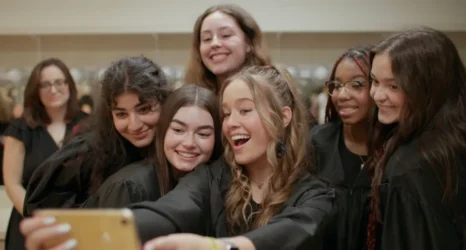It was not lost on some that, 75 years after Hattie McDaniel became the first African American to win a Best Supporting Actress Oscar, the beautiful, poised and talented Lupita Nyong’o would become the sixth black woman to win that same Oscar—and for playing the same type of role, a slave.
If we count Halle Berry’s Oscar for Best Actress in a Leading Role, that brings the full count of African American women Oscar winners to seven. And when we look at the types of portrayals that won these awards—McDaniel as “Mammy,” Whoopi Goldberg as a con-artist spiritual adviser, Halle Berry as an oversexed and imbalanced grieving widow and mother, Jennifer Hudson as a sassy yet rejected lover singing with much attitude, Monique as a deranged abusive welfare mother, Octavia Spencer as a sassy yet abused maid, and now Lupita Nyong’o as a raped, whipped and victimized slave—it’s very easy to imagine that our subservience as black women (or even our hysteria as women in general; just look at the roles that white actresses often win for) is what is recognizable and later celebrated. In short, such recognition might convince us that nothing has changed.
However, I want to challenge that particular narrative: that nothing has changed. If we juxtapose McDaniel’s Mammy alongside Nyong’o’s Patsey, we might realize that, apart from being slaves, their characters are nothing alike. Indeed, from a historical and cinematic context, something significant has changed. Mammy is the mask that pro-slavery apologists used to erase the existence of the Patseys in slavery. It is remarkable that it took 75 years to remove that mask from depictions of cinematic slavery.
There are other changes that we cannot overlook: The fact that McDaniel was forced to sit in the back row the night of the Oscars ceremony, segregated from the rest of her white cast members in the movie Gone with the Wind, contrasts with Nyong’o sitting up front with all the other A-list stars. There is also the fact that McDaniel and other black actors in the Negro Actors Guild fought to remove the n-word from the script of Gone with the Wind, as well as other offensive scenes of racial degradation (shoe-shining her master’s shoes on her knees, or having Butterfly McQueen’s Prissy eating watermelon or being slapped onscreen by Vivien Leigh’s Scarlett O’Hara). I sometimes wonder: Had the Negro Actors Guild not intervened and those elements remained in the film, would we be able to celebrate this classic without embarrassment? Thanks to the efforts of McDaniel, she infused a long-standing stereotype of Mammy with some complicated humor, and she also helped make Gone with the Wind respectable for later generations.
But this is 2014, and we no longer play to respectability politics. The Civil Rights generation exposed the harsh realities of slavery’s history, with its legacy of racism and white supremacy, through our own felt experiences; the hip-hop generation embraced and poked holes in the n-word with a vengeance; and the millennial generation rightly condemns the nostalgic lies that movies like Birth of a Nation and Gone with the Wind have fostered about slavery. Those lies are hard to erase, since the big, expansive movie screen, with its elaborate montage in Birth and dreamy technicolor Wind, solidified these myths. Against these grand narratives, the marginal and enslaved black woman’s story is often silenced.
It took a no-holds-barred black filmmaker like Steve McQueen to not only face the harshness of slavery—as told in Solomon Northup’s 1853 narrative, Twelve Years a Slave—but to paint its cruelty in sharp colors, to sparingly use sound to build up dread or emotional release and especially to cast a dark-skinned actress such as Nyong’o who could interject sexuality and emotional depth to a character who might otherwise have been reduced to symbolic black woman victimhood. Instead, she emerged as the emotional center in one of the few slave movies that fully humanizes the slave story.
Which is why the journey from Mammy to Patsey is a historic big deal. The image of Mammy was deliberately designed by pro-slavery advocates to deny the existence of slave rapes. Her dark skin (now celebrated thanks to Nyong’o’s natural beauty) was loudly negated as an aesthetic ideal. Her big and shapeless body created in the white imagination an image of safety, in which racial mixing did not occur except in the realm of loyal servitude and fierce protectionism. Moreover, her unfeminine, aggressive style made it difficult to view her as victimized by the slave system (imagine how Mammy would look in a scene with Michael Fassbender’s terrifying Edwin Epps).
Mammy was literally the visual opposition to Scarlett O’Hara, someone confined to slavery and sidekick status to the white heroine. Contrast such a pairing with Patsey and Mistress Epps (portrayed icily by Sarah Paulson), two women confined to the same man while one is given the privilege of her class position as wife and the power of whiteness to subjugate Patsey to cruelty and violence—an added insult to the injury of sexual violence that Patsey must endure from her master.
12 Years a Slave removes the masks from Gone with the Wind, and we recognize this through the very different depictions of Mammy and Patsey. As we bask in the afterglow of Lupita Nyong’o’s win—the climax to a whirlwind awards season in which we witnessed Nyongo’s transformation “up from slavery” to red-carpet fashion icon and role model for darker-skinned women everywhere—her Oscar acceptance speech said it best:
It does not escape me for one moment that so much joy in my life is thanks to so much pain in someone else’s, and so I salute the spirit of Patsey.
How can we, like Nyong’o, salute the spirit of Patsey? It only took 75 years for us to even catch a glimpse into the truth of her life. I would call that cinematic progress, and it’s merely the tip of the iceberg of painful history that technicolor tried to distort and which we can now watch with a bit more realism.
Top photo from Flickr user pds209; middle photo from joelk75; bottom from gdcgraphics, all under license from Creative Commons 2.0





